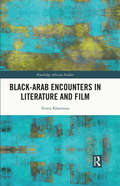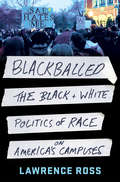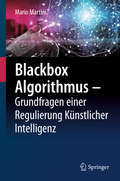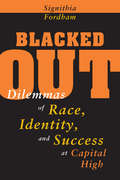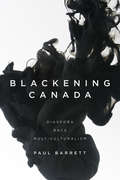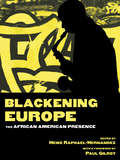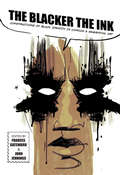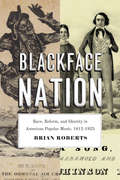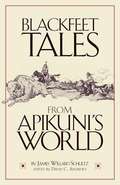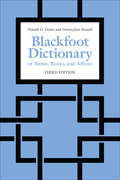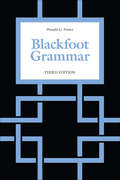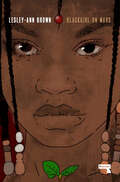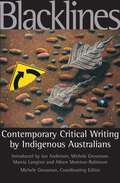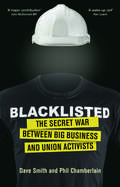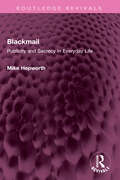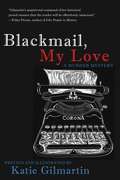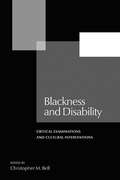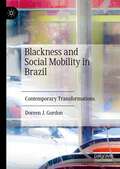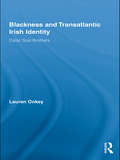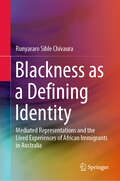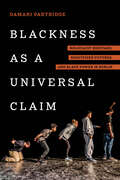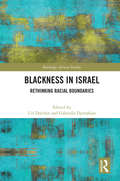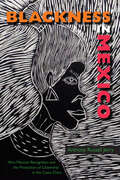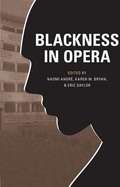- Table View
- List View
Black–Arab Encounters in Literature and Film (Routledge African Studies)
by Touria KhannousThis book investigates how representations of Black Africans have been negotiated over time in Arabic literature and film. The book offers direct readings of a representative selection of primary texts, shedding light on the divergent ways these authors understood race across different genres, including pre-Islamic classical poetry, polemical essays, travel narratives, novels, and films. Starting with the first recognized Black-Arab poet Antara Ibn Shaddad (580 C.E.) and extending right up to the present day, the works examined illuminate the changes in consciousness that attended Black Africans as they negotiated their position in Arab society. In a twist to Edward Said’s Orientalism, the book argues that scholars in the Middle East and North Africa generated a hierarchical representational discourse themselves, one equally predicated on the Self-Other binary. However, it also demonstrates that Arab racial discourse is not a linear rhetoric but changes according to history, political circumstances, and ideologies such as tribal politics, the Shu’ubiyya movement, nationalism, and imperialism. Blacks and Arabs have had tangled relationships that are based not only on race but also on kinship and solidarity due to trade and other types of connections. Challenging fundamental assumptions of Black Diaspora studies and postcolonial studies, this book will be of interest to scholars of the African diaspora, Arabic literature, Middle East studies, and critical race studies.
Blackballed: The Black and White Politics of Race on America's Campuses
by Lawrence Ross"College" is a word that means many things to many people: a space for knowledge, a place to gain lifelong friends, and an opportunity to transcend one's socioeconomic station. Today, though, this word also recalls a slew of headlines that have revealed a dark and persistent world of racial politics on campus. Does this association disturb our idealized visions of what happens behind the ivied walls of higher learning? It should - because campus racism on college campuses is as American as college football on Fall Saturdays. From Lawrence Ross, author of The Divine Nine and the leading expert on sororities and fraternities, Blackballed is an explosive and controversial book that rips the veil off America's hidden secret: America's colleges have fostered a racist environment that makes them a hostile space for African American students. Blackballed exposes the white fraternity and sorority system, with traditions of racist parties, songs, and assaults on black students; and the universities themselves, who name campus buildings after racist men and women. It also takes a deep dive into anti-affirmative action policies, and how they effectively segregate predominately white universities, providing ample room for white privilege. A bold mix of history and the current climate, Blackballed is a call to action for universities to make radical changes to their policies and standards to foster a better legacy for all students.
Blackbox Algorithmus – Grundfragen einer Regulierung Künstlicher Intelligenz
by Mario MartiniDieses Buch liefert eine rechtswissenschaftliche Analyse der Chancen und Gefahren algorithmenbasierter Verfahren. Algorithmen, die im Maschinenraum moderner Softwareanwendungen werkeln, sind zu zentralen Steuerungsinstanzen der digitalen Gesellschaft avanciert. Immer nachhaltiger beeinflussen sie unser Leben. Ihre Funktionsweise gleicht aber teilweise einer Blackbox. Die in ihr schlummernden Risiken zu bändigen, fordert die Rechtsordnung heraus. Das Buch beleuchtet die gesellschaftlichen Gefahren einer zunehmenden gesellschaftlichen Steuerung durch Algorithmen und entwickelt erste Regulierungsideen, mit deren Hilfe sich die Wertschöpfungspotenziale automatisierter digitaler Prozesse mit den Grundwerten der Rechtsordnung versöhnen lassen.
Blacked Out: Dilemmas of Race, Identity, and Success at Capital High
by Signithia FordhamThis innovative portrait of student life in an urban high school focuses on the academic success of African-American students, exploring the symbolic role of academic achievement within the Black community and investigating the price students pay for attaining it. Signithia Fordham's richly detailed ethnography reveals a deeply rooted cultural system that favors egalitarianism and group cohesion over the individualistic, competitive demands of academic success and sheds new light on the sources of academic performance. She also details the ways in which the achievements of sucessful African-Americans are "blacked out" of the public imagination and negative images are reflected onto black adolescents. A self-proclaimed "native" anthropologist, she chronicles the struggle of African-American students to construct an identity suitable to themselves, their peers, and their families within an arena of colliding ideals. This long-overdue contribution is of crucial importance to educators, policymakers, and ethnographers.
Blacked Out: Dilemmas of Race, Identity, and Success at Capital High
by Signithia FordhamThis innovative portrait of student life in an urban high school focuses on the academic success of African-American students, exploring the symbolic role of academic achievement within the Black community and investigating the price students pay for attaining it. Signithia Fordham's richly detailed ethnography reveals a deeply rooted cultural system that favors egalitarianism and group cohesion over the individualistic, competitive demands of academic success and sheds new light on the sources of academic performance. She also details the ways in which the achievements of sucessful African-Americans are "blacked out" of the public imagination and negative images are reflected onto black adolescents. A self-proclaimed "native" anthropologist, she chronicles the struggle of African-American students to construct an identity suitable to themselves, their peers, and their families within an arena of colliding ideals. This long-overdue contribution is of crucial importance to educators, policymakers, and ethnographers.
Blackening Canada
by Paul BarrettFocusing on the work of black, diasporic writers in Canada, particularly Dionne Brand, Austin Clarke, and Tessa McWatt, Blackening Canada investigates the manner in which literature can transform conceptions of nation and diaspora. Through a consideration of literary representation, public discourse, and the language of political protest, Paul Barrett argues that Canadian multiculturalism uniquely enables black diasporic writers to transform national literature and identity. These writers seize upon the ambiguities and tensions within Canadian discourses of nation to rewrite the nation from a black, diasporic perspective, converting exclusion from the national discourse into the impetus for their creative endeavours.Within this context, Barrett suggests, debates over who counts as Canadian, the limits of tolerance, and the breaking points of Canadian multiculturalism serve not as signs of multiculturalism's failure but as proof of both its vitality and of the unique challenges that black writing in Canada poses to multicultural politics and the nation itself.
Blackening Europe: The African American Presence (Crosscurrents in African American History)
by Heike Raphael-HernandezTraditional Scholars have often looked at African American studies through the lens of European theories, resulting in the secondarization of the African American presence in Europe and its contributions to European culture. Blackening Europe reverses this pattern by using African American culture as the starting point for a discussion of its influences over traditional European structures. Evidence of Europe's blackening abound, form French ministers of Hip-hop and British incarnations of "Shaft" to slavery memorial in the Netherlands and German youth sporting dreadlocks. Collecting essays by scholars from both sides of the Atlantic and fields as diverse as history, literature, politics, social studies, art, film and music, Blackening Europe explores the implications of these cultural hybrids and extends the growing dialogues about Europe's fascination with African America.
The Blacker the Ink
by John Jennings Craig Fischer Frances Gateward Rebecca Wanzo William Lafi Youmans Kinohi Nishikawa Blair Davis Nancy Goldstein Daniel F. Yezbick Sally Mcwilliams James J. Zeigler Qiana Whitted Reynaldo Anderson Hershini Bhana Young Robin Means Coleman Patrick F. Walter Consuela Francis Andre CarringtonWhen many think of comic books the first thing that comes to mind are caped crusaders and spandex-wearing super-heroes. Perhaps, inevitably, these images are of white men (and more rarely, women). It was not until the 1970s that African American superheroes such as Luke Cage, Blade, and others emerged. But as this exciting new collection reveals, these superhero comics are only one small component in a wealth of representations of black characters within comic strips, comic books, and graphic novels over the past century. The Blacker the Ink is the first book to explore not only the diverse range of black characters in comics, but also the multitude of ways that black artists, writers, and publishers have made a mark on the industry. Organized thematically into "panels" in tribute to sequential art published in the funny pages of newspapers, the fifteen original essays take us on a journey that reaches from the African American newspaper comics of the 1930s to the Francophone graphic novels of the 2000s. Even as it demonstrates the wide spectrum of images of African Americans in comics and sequential art, the collection also identifies common character types and themes running through everything from the strip The Boondocks to the graphic novel Nat Turner. Though it does not shy away from examining the legacy of racial stereotypes in comics and racial biases in the industry, The Blacker the Ink also offers inspiring stories of trailblazing African American artists and writers. Whether you are a diehard comic book fan or a casual reader of the funny pages, these essays will give you a new appreciation for how black characters and creators have brought a vibrant splash of color to the world of comics.
Blackface Nation: Race, Reform, and Identity in American Popular Music, 1812–1925
by Brian RobertsAs the United States transitioned from a rural nation to an urbanized, industrial giant between the War of 1812 and the early twentieth century, ordinary people struggled over the question of what it meant to be American. As Brian Roberts shows in Blackface Nation, this struggle is especially evident in popular culture and the interplay between two specific strains of music: middle-class folk and blackface minstrelsy. The Hutchinson Family Singers, the Northeast’s most popular middle-class singing group during the mid-nineteenth century, is perhaps the best example of the first strain of music. The group’s songs expressed an American identity rooted in communal values, with lyrics focusing on abolition, women’s rights, and socialism. Blackface minstrelsy, on the other hand, emerged out of an audience-based coalition of Northern business elites, Southern slaveholders, and young, white, working-class men, for whom blackface expressed an identity rooted in individual self-expression, anti-intellectualism, and white superiority. Its performers embodied the love-crime version of racism, in which vast swaths of the white public adored African Americans who fit blackface stereotypes even as they used those stereotypes to rationalize white supremacy. By the early twentieth century, the blackface version of the American identity had become a part of America’s consumer culture while the Hutchinsons’ songs were increasingly regarded as old-fashioned. Blackface Nation elucidates the central irony in America’s musical history: much of the music that has been interpreted as black, authentic, and expressive was invented, performed, and enjoyed by people who believed strongly in white superiority. At the same time, the music often depicted as white, repressed, and boringly bourgeois was often socially and racially inclusive, committed to reform, and devoted to challenging the immoralities at the heart of America’s capitalist order.
Blackfeet Tales from Apikuni's World
by James Willard Schultz David C. AndrewsA collection of short stories as they appeared in magazines in the early 1900's. These stories chronicle life experiences among the Black Feet Indians. The scholarly notes by the editor, David Andrews discuss the author and his legacy.
Blackfoot Dictionary of Stems, Roots, and Affixes: Third Edition
by Donald Frantz Norma Jean RussellThe Blackfoot Dictionary is a comprehensive guide to the vocabulary of Blackfoot, an Algonquian language spoken by thousands in Alberta and Montana. This third edition of the critically acclaimed dictionary adds more than 1,100 new entries, major additions to verb stems, and the inclusion of vai, vii, vta, and viti syntactic categories. It contains more than 5,500 Blackfoot-English entries and an English index of more than 6,000 entries, and provides thorough coverage of cultural terms. The transcription uses an official, technically accurate alphabet and the authors have classified entries and selected examples based on more than 46 years of research.
Blackfoot Grammar: Third Edition
by Donald G. FrantzAlthough thousands of people in Alberta and Montana speak Blackfoot, an Algonquian language, their numbers are diminishing and the survival of Blackfoot is in danger. Blackfoot Grammar, the companion volume to The Blackfoot Dictionary of Stems, Roots and Affixes Third Edition, provides description and analyses of the major features of Blackfoot grammar and language structures. The changes throughout this third edition reflect approaches refined through years of teaching experience. A new appendix, featuring a lengthy Blackfoot text with interlinear English translation has been added, as well as numerous corrections and additions to every chapter. This third edition of Blackfoot Grammar will be a welcome resource not only for those who wish to learn the language, but for all those with an interest in Native Studies and North American linguistics.
Blackgirl on Mars
by Lesley-Ann BrownBlackgirl on Mars is a radical memoir that chronicles author, educator and activist Lesley-Ann Brown's two years' worth of travel searching for "home".As she travels across the US during the Black Lives Matter protests and Covid-19 pandemic and then to Trinidad and Tobago to attend the funeral of her grandmother, Brown tells her own life-story, as well as writing about race, gender, sexuality, and education, and ideas of home, family and healing.Both a radical political manifesto and a moving memoir about finding your place in the world, Blackgirl on Mars is about what it means to be a Black and Indigenous woman in Europe and the Americas in the twenty-first century.
Blacklines: Contemporary Critical Writings By Indigenous Australians
by Michele GrossmanWritten by established and emerging Indigenous intellectuals from a variety of positions, perspectives and places, these essays generate new ways of seeing and understanding Indigenous Australian history, culture, identity and knowledge in both national and global contexts. From museums to Mabo, anthropology to art, feminism to film, land rights to literature, the essays collected here offer provocative insights and compelling arguments around the historical and contemporary issues confronting Indigenous Australians today.
Blacklisted
by Dave Smith Phil ChamberlainBlacklisted tells the explosive story of the illegal strategies used by transnational construction companies to deny union activists work.This is the story of a bitter struggle, in which employers' collusion with the police and security services resulted in victimization, violence and unemployment, with terrible effects on families and communities.Investigative journalist Phil Chamberlain and Dave Smith, campaigner and victim of blacklisting, lift the lid on the shameful and immoral practices that went on behind the scaffolding. Hundreds of testimonies (blacklisted workers, Special Branch spies, company representatives, union members and more) and extracts from blacklist files expose the scale of the scandal and the human stories behind the secret war. In forensic detail the authors make a powerful and unequivocal case for human rights and for justice to finally be done.
Blackmail: Publicity and Secrecy in Everyday Life (Routledge Revivals)
by Mike HepworthFirst Published in 1975 Blackmail: Publicity and Secrecy in Everyday Life examines why blackmail is often taken more seriously than murder and why it is widely considered as a serious social threat. Both fictional and real-life situations are used to explore the kinds of social situation in which various individuals become vulnerable to blackmail. In isolating the key ingredients of reputational blackmail in Britain over the last hundred years, this book is not preoccupied with threats to accuse someone of a major criminal offence such as murder or armed robbery, but rather with those cases where the penalties of discovery are less clear-cut and where public reaction may be much more ambivalent. Mike Hepworth focuses attention on the way blackmail is stigmatized in criminological and other literature and the possible validity of the stereotype in the light of alternative interpretations. This book is an interesting read for scholars and researchers of criminology and sociology.
Blackmail, My Love
by Katie GilmartinJosie O'Conner travels to San Francisco in 1951 to locate her gay brother, a private dick investigating a blackmail ring targeting lesbians and gay men. Jimmy's friends claim that just before he disappeared he became a rat, informing the cops on the bar community. Josie adopts Jimmy's trousers and wingtips, battling to clear his name, halt the blackmailers, and exact justice for the many queer corpses. Along the way she rubs shoulders with a sultry chanteuse running a dyke tavern called Pandora's Box, gets intimate with a red-headed madam operating a brothel from the Police Personnel Department, and conspires with the star of Finocchio's, a dive so disreputable it's off limits to servicemen - so every man in uniform pays a visit.Blackmail, My Love is an illustrated murder mystery deeply steeped in San Francisco's queer history. Established academic and first-time novelist Katie Gilmartin's diverse set of characters negotiate the risks of same-sex desire in a tough time for queers. Humor leavens the grave subject matter. Set in such legendary locations as the Black Cat Cafe, the Fillmore, the Beat movement's North Beach, and the sexually complex Tenderloin, Blackmail, My Love is a singular, visually stunning neo-noir experience.
Blackness and Disability: Critical Examinations and Cultural Interventions
by Christopher M. BellThis pivotal volume uncovers the misrepresentations of black disabled bodies and demonstrates how those bodies transform systems and culture. Drawing on key themes in Disability Studies and African American Studies, these collected essays complement one another in interesting and dynamic ways, to forge connections across genres and chronotopes, an invitation to keep blackness and disability in conversation.
Blackness and Social Mobility in Brazil: Contemporary Transformations
by Doreen Joy GordonThis book examines the emergence of the black middle classes in urban Brazil, after 30 years of black mobilization and against the backdrop of deep economic, cultural, and political transformations taking place in recent decades within the country. One of the consequences of such transformations is said to be the restructuring of gender, race, and class relations. Utilizing qualitative research techniques such as ethnography, interviews, life histories, and focus groups among Afro-descendant families in the Northeast region of the country, the book explores contemporary race, class, and gender inequalities and their impact on daily lived experience. It reveals the dynamics underlying upward mobility, the diverse modes and experiences of social ascent into the middle classes, and the everyday negotiations involved in establishing one's status in the socio-racial hierarchy, which are not captured by other, more "macro" lenses. While some of these patterns are not peculiar to black people, this book argues that "race" shaped the contours and possibilities of social mobility in particular ways. This book is critical reading for specialists in the fields of inequality and race, class, and gender relations.
Blackness and Transatlantic Irish Identity: Celtic Soul Brothers (Routledge Research in Race and Ethnicity)
by Lauren OnkeyBlackness and Transatlantic Irish Identity analyzes the long history of imagined and real relationships between the Irish and African-Americans since the mid-nineteenth century in popular culture and literature. Irish writers and political activists have often claimed - and thereby created - a "black" identity to explain their experience with colonialism in Ireland and revere African-Americans as a source of spiritual and sexual vitality. Irish-Americans often resisted this identification so as to make a place for themselves in the U.S. However, their representation of an Irish-American identity pivots on a distinction between Irish-Americans and African-Americans. Lauren Onkey argues that one of the most consistent tropes in the assertion of Irish and Irish-American identity is constructed through or against African-Americans, and she maps that trope in the work of writers Roddy Doyle, James Farrell, Bernard MacLaverty, John Boyle O’Reilly, and Jimmy Breslin; playwright Ned Harrigan; political activists Bernadette Devlin and Tom Hayden; and musicians Van Morrison, U2, and Black 47.
Blackness as a Defining Identity: Mediated Representations and the Lived Experiences of African Immigrants in Australia
by Runyararo Sihle ChivauraThis book explores the lived experiences of African immigrants in Australia, and the way they are represented in the media. By delving into the group’s everyday lives, the book exposes the roles that media and social perceptions play in the production and regulation of diasporic identities. Rather than being presented as objects of mediated representations, this book positions African immigrants in Australia as empowered subjects. The book employs inclusive research methods that make African immigrants active participants in the research, rather than passive objects. This is achieved through an expanded demographic study, a snapshot survey, and by taking a closer look at the lives of Africans in Australia through digital oral histories. This approach allows the group to have a say on how they feel they are positioned in society, on what space they are offered, and on how this affects their lives.
Blackness as a Universal Claim: Holocaust Heritage, Noncitizen Futures, and Black Power in Berlin
by Damani J. PartridgeIn this bold and provocative book, Damani J. Partridge examines the possibilities and limits of a universalized Black politics. Young people in Germany of Turkish, Arab, and African descent use claims of Blackness to hold states and other institutions accountable for their everyday struggle. Partridge tracks how these youth invoke the expressions of Black Power, acting out the medal-podium salute from the 1968 Olympics, proclaiming "I am Malcolm X," expressing mutual struggle with Muhammad Ali and Spike Lee, and standing with raised and clenched fists next to Angela Davis. Partridge also documents the demands by public-school teachers, federal-program leaders, and politicians that young immigrants account for the global persistence of anti-Semitism as part of the German state's commitment to antigenocidal education. He uses these stories to interrogate the relationships among European Enlightenment, Holocaust memory, and Black futures, showing how noncitizens work to reshape their everyday lives. In doing so, he demonstrates how the concept of Blackness energizes, inspires, and makes possible participation beyond national belonging for immigrants, refugees, Black people, and other People of Color.
Blackness in Israel: Rethinking Racial Boundaries (Routledge African Studies)
by Uri Dorchin Gabriella DjerrahianThis book explores contemporary inflections of blackness in Israel and foreground them in the historical geographies of Europe, the Middle East, and North America. The contributors engage with expressions and appropriations of modern forms of blackness for boundary-making, boundary-breaking, and boundary-re-making in contemporary Israel, underscoring the deep historical roots of contemporary understandings of race, blackness, and Jewishness. Allowing a new perspective on the sociology of Israel and the realm of black studies, this volume reveals a highly nuanced portrait of the phenomenon of blackness, one that is located at the nexus of global, regional, national and local dimensions. While race has been discussed as it pertains to Judaism at large, and Israeli society in particular, blackness as a conceptual tool divorced from phenotype, skin tone and even music has yet to be explored. Grounded in ethnographic research, the study demonstrates that many ethno-racial groups that constitute Israeli society intimately engage with blackness as it is repeatedly and explicitly addressed by a wide array of social actors. Enhancing our understanding of the politics of identity, rights, and victimhood embedded within the rhetoric of blackness in contemporary Israel, this book will be of interest to scholars of blackness, globalization, immigration, and diaspora.
Blackness in Mexico: Afro-Mexican Recognition and the Production of Citizenship in the Costa Chica (New World Diasporas)
by Anthony Russell JerryAn up-close view of the movement to make “Afro-Mexican” an official cultural category Through historical and ethnographic research, Blackness in Mexico delves into the ongoing movement toward recognizing Black Mexicans as a cultural group within a nation that has long viewed the non-Black Mestizo as the archetypal citizen. Anthony Jerry focuses on this process in Mexico’s Costa Chica region in order to explore the relational aspects of citizenship and the place of Black people in how modern citizenship is imagined. Jerry’s study of the Costa Chica shows the political stakes of the national project for Black recognition; the shared but competing interests of the Mexican government, activists, and townspeople; and the ways that the state and NGOs are working to make “Afro-Mexican” an official cultural category. He argues that that the demand for recognition by Black communities calls attention to how the Mestizo has become an intuitive point of reference for identifying who qualifies as “other.” Jerry also demonstrates that while official recognition can potentially empower African descendants, it can simultaneously reproduce the same logics of difference that have brought about their social and political exclusion. One of few books to center Blackness within a discussion of Mexico or to incorporate a focus on Mexico into Black studies, this book ultimately argues that the official project for recognition is itself a methodology of mestizaje, an opportunity for the government to continue to use Blackness to define the national subject and to further the Mexican national project. A volume in the series New World Diasporas, edited by Kevin A. Yelvington Publication of this work made possible by a Sustaining the Humanities through the American Rescue Plan grant from the National Endowment for the Humanities.
Blackness in Opera
by Guthrie Ramsey Eric Saylor Karen M. Bryan Naomi AndreBlackness in Opera critically examines the intersections of race and music in the multifaceted genre of opera. A diverse cross-section of scholars places well-known operas (Porgy and Bess, Aida, Treemonisha) alongside lesser-known works such as Frederick Delius's Koanga, William Grant Still's Blue Steel, and Clarence Cameron White's Ouanga! to reveal a new historical context for re-imagining race and blackness in opera. The volume brings a wide-ranging, theoretically informed, interdisciplinary approach to questions about how blackness has been represented in these operas, issues surrounding characterization of blacks, interpretation of racialized roles by blacks and whites, controversies over race in the theatre and the use of blackface, and extensions of blackness along the spectrum from grand opera to musical theatre and film. In addition to essays by scholars, the book also features reflections by renowned American tenor George Shirley. Contributors are Naomi André, Melinda Boyd, Gwynne Kuhner Brown, Karen M. Bryan, Melissa J. de Graaf, Christopher R. Gauthier, Jennifer McFarlane-Harris, Gayle Murchison, Guthrie P. Ramsey Jr., Eric Saylor, Sarah Schmalenberger, Ann Sears, George Shirley, and Jonathan O. Wipplinger.
